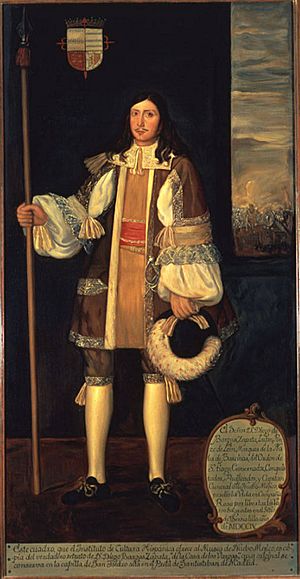Diego de Vargas facts for kids
Quick facts for kids
Diego de Vargas Zapata y Luján Ponce de León y Contreras
|
|
|---|---|

Oil on canvas portrait of Diego de Vargas by Julio Barrera, date unknown, from the collection of the Palace of the Governors
|
|
| 30 and 32nd Spanish Governor of New Mexico | |
| In office 1691 – 1697 (as effective) (titular 1688–91) |
|
| Preceded by | Domingo Jironza Petriz de Cruzate |
| Succeeded by | Pedro Rodríguez Cubero |
| In office 1697–1703 |
|
| Preceded by | Pedro Rodríguez Cubero |
| Succeeded by | Juan Páez Hurtado |
| Personal details | |
| Born | 1643 Madrid, Spain |
| Died | 1704 Bernalillo, Nuevo México (New Mexico) |
| Profession | Political and military |
| Signature |  |
Diego de Vargas Zapata y Luján Ponce de León y Contreras (1643–1704) was an important Spanish leader. He is often called Don Diego de Vargas. He served as a Spanish Governor of a large area called Santa Fe de Nuevo México. This land is now part of the US states of New Mexico and Arizona.
De Vargas is best known for leading the "reconquest" of this territory in 1692. This happened after the Pueblo Revolt of 1680. The reconquest is still remembered each year during the Fiestas de Santa Fe in Santa Fe.
Contents
The Pueblo Revolt and Reconquest
What Was the Pueblo Revolt?
On August 10, 1680, Pueblo people from different villages in northern New Mexico started an uprising. They fought against the Spanish colonists. The Pueblo people surrounded the city of Santa Fe. This forced the Spanish colonists to leave on August 20. The Spanish colonists went south to El Paso del Norte. This city is now called Ciudad Juárez in Mexico. They stayed there for 16 years.
De Vargas Takes Charge
In 1688, Don Diego de Vargas was chosen to be the Governor of New Mexico. He arrived to start his job on February 22, 1691. His main task was to take back the New Mexico territory for Spain. He also had to make peace in the area.
In July 1692, de Vargas and a small group of soldiers returned to Santa Fe. They surrounded the city. De Vargas asked the Pueblo people to give up. He promised to be fair if they would promise loyalty to the King of Spain. He also asked them to return to the Christian faith.
A Peaceful Return?
After talking with de Vargas, the Pueblo leaders agreed to surrender. On September 12, 1692, de Vargas officially took back the land. This event is often called a "bloodless reconquest." This is because the territory was first taken back without fighting.
De Vargas had prayed to the Virgin Mary, known as La Conquistadora. He believed she helped him achieve the peaceful return. To thank her, he held a special celebration.
Fiestas de Santa Fe Today
Today, this celebration continues every year in Santa Fe as the Fiestas de Santa Fe. Part of these yearly fiestas is a series of special church services. These services give thanks for the peaceful return. They also include parades from the Cathedral Basilica of St. Francis of Assisi to the Rosario Chapel. A special statue of La Conquistadora is carried in these parades. After the services, the statue is returned to the Basilica. Both local Native American tribes and Latino families take part in this event.
In recent years, some Native American groups have protested parts of the Fiestas. They say that the "Entrada" reenactment is not historically accurate. The Entrada showed de Vargas's return to Santa Fe. Protests against the Entrada began in 2015. In 2017, some protestors were arrested. After these protests, the Entrada was removed from the Santa Fe Fiesta celebration.
Statue of Diego de Vargas
On June 18, 2020, the city of Santa Fe, New Mexico removed a Statue of Diego de Vargas. This statue had been put up 150 years earlier. It was one of several statues removed across the United States. This happened as part of wider efforts to remove controversial statues.
Notable People Who Traveled with Vargas
Here are some important soldiers who traveled with Diego de Vargas:
- Ignacio Roibal (Roybal) – He owned the historic Sena Plaza in Santa Fe.
- Alonso Rael de Aguilar – He was de Vargas's Secretary of Government and War.
- Juan de Ulibarrí – He was a soldier and explorer of the Great Plains.
- Captain Don Fernando Durán y Chaves (born 1651, died between 1712 and 1716).
See also
 In Spanish: Diego de Vargas para niños
In Spanish: Diego de Vargas para niños

